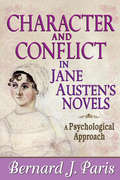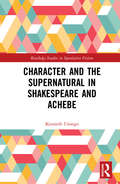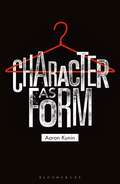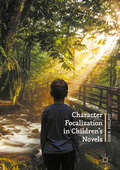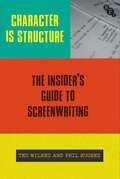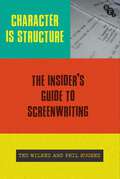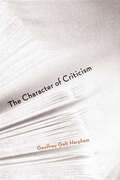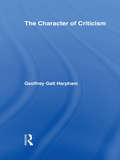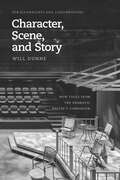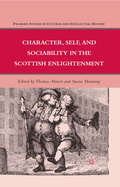- Table View
- List View
Character: Three Inquiries in Literary Studies (TRIOS)
by Amanda Anderson Rita Felski Toril MoiOver the last few decades, character-based criticism has been seen as either naive or obsolete. But now questions of character are attracting renewed interest. Making the case for a broad-based revision of our understanding of character, Character rethinks these questions from the ground up. Is it really necessary to remind literary critics that characters are made up of words? Must we forbid identification with characters? Does character-discussion force critics to embrace humanism and outmoded theories of the subject? Across three chapters, leading scholars Amanda Anderson, Rita Felski, and Toril Moi reimagine and renew literary studies by engaging in a conversation about character. Moi returns to the fundamental theoretical assumptions that convinced literary scholars to stop doing character-criticism, and shows that they cannot hold. Felski turns to the question of identification and draws out its diverse strands, as well as its persistence in academic criticism. Anderson shows that character-criticism illuminates both the moral life of characters, and our understanding of literary form. In offering new perspectives on the question of fictional character, this thought-provoking book makes an important intervention in literary studies.
Character: Three Inquiries in Literary Studies (TRIOS)
by Amanda Anderson Rita Felski Toril MoiOver the last few decades, character-based criticism has been seen as either naive or obsolete. But now questions of character are attracting renewed interest. Making the case for a broad-based revision of our understanding of character, Character rethinks these questions from the ground up. Is it really necessary to remind literary critics that characters are made up of words? Must we forbid identification with characters? Does character-discussion force critics to embrace humanism and outmoded theories of the subject? Across three chapters, leading scholars Amanda Anderson, Rita Felski, and Toril Moi reimagine and renew literary studies by engaging in a conversation about character. Moi returns to the fundamental theoretical assumptions that convinced literary scholars to stop doing character-criticism, and shows that they cannot hold. Felski turns to the question of identification and draws out its diverse strands, as well as its persistence in academic criticism. Anderson shows that character-criticism illuminates both the moral life of characters, and our understanding of literary form. In offering new perspectives on the question of fictional character, this thought-provoking book makes an important intervention in literary studies.
Character: Three Inquiries in Literary Studies (TRIOS)
by Amanda Anderson Rita Felski Toril MoiOver the last few decades, character-based criticism has been seen as either naive or obsolete. But now questions of character are attracting renewed interest. Making the case for a broad-based revision of our understanding of character, Character rethinks these questions from the ground up. Is it really necessary to remind literary critics that characters are made up of words? Must we forbid identification with characters? Does character-discussion force critics to embrace humanism and outmoded theories of the subject? Across three chapters, leading scholars Amanda Anderson, Rita Felski, and Toril Moi reimagine and renew literary studies by engaging in a conversation about character. Moi returns to the fundamental theoretical assumptions that convinced literary scholars to stop doing character-criticism, and shows that they cannot hold. Felski turns to the question of identification and draws out its diverse strands, as well as its persistence in academic criticism. Anderson shows that character-criticism illuminates both the moral life of characters, and our understanding of literary form. In offering new perspectives on the question of fictional character, this thought-provoking book makes an important intervention in literary studies.
Character: Three Inquiries in Literary Studies (TRIOS)
by Amanda Anderson Rita Felski Toril MoiOver the last few decades, character-based criticism has been seen as either naive or obsolete. But now questions of character are attracting renewed interest. Making the case for a broad-based revision of our understanding of character, Character rethinks these questions from the ground up. Is it really necessary to remind literary critics that characters are made up of words? Must we forbid identification with characters? Does character-discussion force critics to embrace humanism and outmoded theories of the subject? Across three chapters, leading scholars Amanda Anderson, Rita Felski, and Toril Moi reimagine and renew literary studies by engaging in a conversation about character. Moi returns to the fundamental theoretical assumptions that convinced literary scholars to stop doing character-criticism, and shows that they cannot hold. Felski turns to the question of identification and draws out its diverse strands, as well as its persistence in academic criticism. Anderson shows that character-criticism illuminates both the moral life of characters, and our understanding of literary form. In offering new perspectives on the question of fictional character, this thought-provoking book makes an important intervention in literary studies.
Character and Caricature, 1660-1820
by Jennifer Buckley Montana Davies-ShuckThis edited collection offers a reappraisal of character as a precondition for caricature and addresses how the two began to merge, becoming increasingly interlinked over the course of the long eighteenth century. It emphasises the need to understand character more fully, arguing that the nuances and origins of caricature can only be appreciated in light of the genre’s prehistory and reliance on popular character types. Interdisciplinary and multidisciplinary in approach, the collection makes use of a variety of theories and addresses fiction in its broadest sense, expanding and reconceptualising critical, historical and theoretical discussion of character. Chapters draw from disability studies, cultural materialism, gender studies and the history of sexuality, spatial theory and performance studies.
Character and Conflict in Jane Austen's Novels: A Psychological Approach
by Bernard J. ParisIn Character and Conflict in Jane Austen's Novels , Bernard J. Paris offers an analysis of the protagonists in four of Jane Austen's most popular novels. His analysis reveals them to be brilliant mimetic creations who often break free of the formal and thematic limitations placed upon them by Austen. Paris traces the powerful tensions between form, theme, and mimesis in Mansfield Park , Emma , Pride and Prejudice , and Persuasion . Paris uses Northrop Frye's theory of comic forms to analyse and describe the formal structure of the novels, and Karen Horney's psychological theories to explore the personalities and inner conflicts of the main characters. The concluding chapter turns from the characters to their creator, employing the Horneyan categories of self-effacing, detached, and expansive personality types to interpret Jane Austen's own personality. Readers of Jane Austen will find much that is new and challenging in this study. It is one of the few books to recognise and pay tribute to Jane Austen's genius in characterisation. Anyone who reads this book will come away with a new understanding of Austen's heroines as imagined human beings and also with a deeper feeling for the troubled humanity of the author herself.
Character and Conflict in Jane Austen's Novels: A Psychological Approach
by Bernard J. ParisIn Character and Conflict in Jane Austen's Novels , Bernard J. Paris offers an analysis of the protagonists in four of Jane Austen's most popular novels. His analysis reveals them to be brilliant mimetic creations who often break free of the formal and thematic limitations placed upon them by Austen. Paris traces the powerful tensions between form, theme, and mimesis in Mansfield Park , Emma , Pride and Prejudice , and Persuasion . Paris uses Northrop Frye's theory of comic forms to analyse and describe the formal structure of the novels, and Karen Horney's psychological theories to explore the personalities and inner conflicts of the main characters. The concluding chapter turns from the characters to their creator, employing the Horneyan categories of self-effacing, detached, and expansive personality types to interpret Jane Austen's own personality. Readers of Jane Austen will find much that is new and challenging in this study. It is one of the few books to recognise and pay tribute to Jane Austen's genius in characterisation. Anyone who reads this book will come away with a new understanding of Austen's heroines as imagined human beings and also with a deeper feeling for the troubled humanity of the author herself.
Character and Satire in Post War Fiction (Continuum Literary Studies)
by Ian GregsonThis monograph analyses the use of caricature as one of the key strategies in narrative fiction since the war. Close analysis of some of the best known postwar novelists including Toni Morrison, Philip Roth, Joyce Carol Oates, Angela Carter and Will Self, reveals how they use caricature to express postmodern conceptions of the self. In the process of moving away from the modernist focus on subjectivity, postmodern characterisation has often drawn on a much older satirical tradition which includes Hogarth and Gillray in the visual arts, and Dryden, Pope, Swift and Dickens in literature. Its key images depict the human as reduced to the status of an object, an animal or a machine, or the human body as dismembered to represent the fragmentation of the human spirit. Gregson argues that this return to caricature is symptomatic of a satirical attitude to the self which is particularly characteristic of contemporary culture.
Character and Satire in Post War Fiction (Continuum Literary Studies)
by Ian GregsonThis monograph analyses the use of caricature as one of the key strategies in narrative fiction since the war. Close analysis of some of the best known postwar novelists including Toni Morrison, Philip Roth, Joyce Carol Oates, Angela Carter and Will Self, reveals how they use caricature to express postmodern conceptions of the self. In the process of moving away from the modernist focus on subjectivity, postmodern characterisation has often drawn on a much older satirical tradition which includes Hogarth and Gillray in the visual arts, and Dryden, Pope, Swift and Dickens in literature. Its key images depict the human as reduced to the status of an object, an animal or a machine, or the human body as dismembered to represent the fragmentation of the human spirit. Gregson argues that this return to caricature is symptomatic of a satirical attitude to the self which is particularly characteristic of contemporary culture.
Character and the Supernatural in Shakespeare and Achebe (Routledge Studies in Speculative Fiction)
by Kenneth UsongoThrough mainly a New Historicist critical approach, this book explores how Shakespeare and Achebe employ supernatural devices such as prophecies, dreams, gods/goddesses, beliefs, and divinations to create complex characters. Even though these features indicate the preponderance of the belief in the supernatural by some people of the Elizabethan, Jacobean, and traditional Igbo societies, Shakespeare and Achebe primarily use the supernatural to represent the states of mind of their protagonists. Both writers appropriate supernatural features to mirror tragic flaws such as ambition, arrogance, impulsiveness, and fear that contribute to the downfall of Macbeth, Lear, Okonkwo, and Ezeulu. We relate to some of these characters because they project our inner minds, principal drives that may be hidden within us. Therefore, Shakespeare and Achebe’s preoccupation with the supernatural adds subtlety to their characterization and enhances their readability by situating their art beyond time, place, or particularity.
Character and the Supernatural in Shakespeare and Achebe (Routledge Studies in Speculative Fiction)
by Kenneth UsongoThrough mainly a New Historicist critical approach, this book explores how Shakespeare and Achebe employ supernatural devices such as prophecies, dreams, gods/goddesses, beliefs, and divinations to create complex characters. Even though these features indicate the preponderance of the belief in the supernatural by some people of the Elizabethan, Jacobean, and traditional Igbo societies, Shakespeare and Achebe primarily use the supernatural to represent the states of mind of their protagonists. Both writers appropriate supernatural features to mirror tragic flaws such as ambition, arrogance, impulsiveness, and fear that contribute to the downfall of Macbeth, Lear, Okonkwo, and Ezeulu. We relate to some of these characters because they project our inner minds, principal drives that may be hidden within us. Therefore, Shakespeare and Achebe’s preoccupation with the supernatural adds subtlety to their characterization and enhances their readability by situating their art beyond time, place, or particularity.
Character as Form (Beyond Criticism Ser.)
by Aaron KuninWhat if the Renaissance had the right idea about character? Most readers today think that characters are individuals. Poets of the Renaissance understood characters as types. They thought the job of a character was to collect every example of a kind, in the same way that an entry in a dictionary collects definitions of a word. Character as Form celebrates the old meaning of character. The advantage of the old meaning is that it allows for generalization. Characters funnel whole societies of beings into shapes that are compact, elegant, and portable. This book tests the old meaning of character against modern examples from poems, novels, comics, and performances in theater and film by Shakespeare, Molière, Austen, the Marx Brothers, Raul Ruiz, Denton Welch, and Lynda Barry. The heart of the book is the character of the misanthrope, who, in Shakespeare's phrase, “banishes the world.”
Character as Form (Beyond Criticism Ser.)
by Aaron KuninWhat if the Renaissance had the right idea about character? Most readers today think that characters are individuals. Poets of the Renaissance understood characters as types. They thought the job of a character was to collect every example of a kind, in the same way that an entry in a dictionary collects definitions of a word. Character as Form celebrates the old meaning of character. The advantage of the old meaning is that it allows for generalization. Characters funnel whole societies of beings into shapes that are compact, elegant, and portable. This book tests the old meaning of character against modern examples from poems, novels, comics, and performances in theater and film by Shakespeare, Molière, Austen, the Marx Brothers, Raul Ruiz, Denton Welch, and Lynda Barry. The heart of the book is the character of the misanthrope, who, in Shakespeare's phrase, “banishes the world.”
Character Focalization in Children’s Novels
by Don K. PhilpotThis book offers a comprehensive analysis of character focalization in ten contemporary realistic children’s novels. The author argues that character focalization, defined as the location of fictional world perception in the mind of a character, is a prominent textual structure in these novels. He demonstrates how significant meanings are conveyed in a variety of forms related to characters’ personal and interpersonal experiences. Through close analysis of each text, moreover, he exposes distinctive perceptual, psychological, and social-psychological patterns in the opening chapters of each novel, which are thereafter developed by the principles of continuation, augmentation, and reconfiguration. This book will appeal to scholars, teachers, and students in the fields of narrative studies, stylistics, children’s literature scholarship, linguistics, and education.
Character is Structure: The Insider’s Guide to Screenwriting
by Ted Wilkes Phil HughesThis book seeks to reshape the way that writers think about constructing their story, looking at the subject from the inside out. Often practitioners and theorists examine work through the separate lenses of character and/or structure and then bring them together. Within this book, authors Hughes and Wilkes argue that character is structure and one without the other makes for a dissatisfying narrative.Through detailed case studies on films that span all genres, from mainstream franchises like The Hunger Games (2012-2015) and Shrek (2001-2010) to art house films such as Toto Le Heros (1991) and Eraserhead (1977), the authors reveal the dramatic imperative behind the central choices or dilemmas faced by every protagonist in every classic feature length narrative. They argue there is only one of five choices that any writer must make in inventing that key transition from the protagonist's ordinary world into the adventure that will form the heart of their story.Using the universal language of folk and fairy stories, this book gives writers and students a clear framework through which they can reference and improve their own storytelling. In doing so, it enables both the novice and experienced screenwriter to tell their story in the most authentic and impactful way, while keeping their protagonist at the heart of the narrative.
Character is Structure: The Insider’s Guide to Screenwriting
by Ted Wilkes Phil HughesThis book seeks to reshape the way that writers think about constructing their story, looking at the subject from the inside out. Often practitioners and theorists examine work through the separate lenses of character and/or structure and then bring them together. Within this book, authors Hughes and Wilkes argue that character is structure and one without the other makes for a dissatisfying narrative.Through detailed case studies on films that span all genres, from mainstream franchises like The Hunger Games (2012-2015) and Shrek (2001-2010) to art house films such as Toto Le Heros (1991) and Eraserhead (1977), the authors reveal the dramatic imperative behind the central choices or dilemmas faced by every protagonist in every classic feature length narrative. They argue there is only one of five choices that any writer must make in inventing that key transition from the protagonist's ordinary world into the adventure that will form the heart of their story.Using the universal language of folk and fairy stories, this book gives writers and students a clear framework through which they can reference and improve their own storytelling. In doing so, it enables both the novice and experienced screenwriter to tell their story in the most authentic and impactful way, while keeping their protagonist at the heart of the narrative.
The Character of Criticism
by Geoffrey Galt HarphamFirst published in 2007. Routledge is an imprint of Taylor & Francis, an informa company.
The Character of Criticism
by Geoffrey Galt HarphamFirst published in 2007. Routledge is an imprint of Taylor & Francis, an informa company.
Character, Scene, and Story: New Tools from the Dramatic Writer's Companion (Chicago Guides to Writing, Editing, and Publishing)
by Will DunneWill Dunne first brought the workshop experience down to the desk level with The Dramatic Writer’s Companion, offering practical exercises to help playwrights and screenwriters work through the problems that arise in developing their scripts. Now writers looking to further enhance their storytelling process can turn to Character, Scene, and Story. Featuring forty-two new workshop-tested exercises, this sequel to The Dramatic Writer’s Companion allows writers to dig deeper into their scripts by fleshing out images, exploring characters from an emotional perspective, tapping the power of color and sense memory to trigger ideas, and trying other visceral techniques. The guide also includes a troubleshooting section to help tackle problem scenes. Writers with scripts already in progress will find they can think deeper about their characters and stories. And those who are just beginning to write will find the guidance they need to discover their best starting point. The guide is filled with hundreds of examples, many of which have been developed as both plays and films. Character, Scene, and Story is fully aligned with the new edition of The Dramatic Writer’s Companion, with cross-references between related exercises so that writers have the option to explore a given topic in more depth. While both guides can stand alone, together they give writers more than one hundred tools to develop more vivid characters and craft stronger scripts.
Character, Scene, and Story: New Tools from the Dramatic Writer's Companion (Chicago Guides to Writing, Editing, and Publishing)
by Will DunneWill Dunne first brought the workshop experience down to the desk level with The Dramatic Writer’s Companion, offering practical exercises to help playwrights and screenwriters work through the problems that arise in developing their scripts. Now writers looking to further enhance their storytelling process can turn to Character, Scene, and Story. Featuring forty-two new workshop-tested exercises, this sequel to The Dramatic Writer’s Companion allows writers to dig deeper into their scripts by fleshing out images, exploring characters from an emotional perspective, tapping the power of color and sense memory to trigger ideas, and trying other visceral techniques. The guide also includes a troubleshooting section to help tackle problem scenes. Writers with scripts already in progress will find they can think deeper about their characters and stories. And those who are just beginning to write will find the guidance they need to discover their best starting point. The guide is filled with hundreds of examples, many of which have been developed as both plays and films. Character, Scene, and Story is fully aligned with the new edition of The Dramatic Writer’s Companion, with cross-references between related exercises so that writers have the option to explore a given topic in more depth. While both guides can stand alone, together they give writers more than one hundred tools to develop more vivid characters and craft stronger scripts.
Character, Scene, and Story: New Tools from the Dramatic Writer's Companion (Chicago Guides to Writing, Editing, and Publishing)
by Will DunneWill Dunne first brought the workshop experience down to the desk level with The Dramatic Writer’s Companion, offering practical exercises to help playwrights and screenwriters work through the problems that arise in developing their scripts. Now writers looking to further enhance their storytelling process can turn to Character, Scene, and Story. Featuring forty-two new workshop-tested exercises, this sequel to The Dramatic Writer’s Companion allows writers to dig deeper into their scripts by fleshing out images, exploring characters from an emotional perspective, tapping the power of color and sense memory to trigger ideas, and trying other visceral techniques. The guide also includes a troubleshooting section to help tackle problem scenes. Writers with scripts already in progress will find they can think deeper about their characters and stories. And those who are just beginning to write will find the guidance they need to discover their best starting point. The guide is filled with hundreds of examples, many of which have been developed as both plays and films. Character, Scene, and Story is fully aligned with the new edition of The Dramatic Writer’s Companion, with cross-references between related exercises so that writers have the option to explore a given topic in more depth. While both guides can stand alone, together they give writers more than one hundred tools to develop more vivid characters and craft stronger scripts.
Character, Scene, and Story: New Tools from the Dramatic Writer's Companion (Chicago Guides to Writing, Editing, and Publishing)
by Will DunneWill Dunne first brought the workshop experience down to the desk level with The Dramatic Writer’s Companion, offering practical exercises to help playwrights and screenwriters work through the problems that arise in developing their scripts. Now writers looking to further enhance their storytelling process can turn to Character, Scene, and Story. Featuring forty-two new workshop-tested exercises, this sequel to The Dramatic Writer’s Companion allows writers to dig deeper into their scripts by fleshing out images, exploring characters from an emotional perspective, tapping the power of color and sense memory to trigger ideas, and trying other visceral techniques. The guide also includes a troubleshooting section to help tackle problem scenes. Writers with scripts already in progress will find they can think deeper about their characters and stories. And those who are just beginning to write will find the guidance they need to discover their best starting point. The guide is filled with hundreds of examples, many of which have been developed as both plays and films. Character, Scene, and Story is fully aligned with the new edition of The Dramatic Writer’s Companion, with cross-references between related exercises so that writers have the option to explore a given topic in more depth. While both guides can stand alone, together they give writers more than one hundred tools to develop more vivid characters and craft stronger scripts.
Character, Scene, and Story: New Tools from the Dramatic Writer's Companion (Chicago Guides to Writing, Editing, and Publishing)
by Will DunneWill Dunne first brought the workshop experience down to the desk level with The Dramatic Writer’s Companion, offering practical exercises to help playwrights and screenwriters work through the problems that arise in developing their scripts. Now writers looking to further enhance their storytelling process can turn to Character, Scene, and Story. Featuring forty-two new workshop-tested exercises, this sequel to The Dramatic Writer’s Companion allows writers to dig deeper into their scripts by fleshing out images, exploring characters from an emotional perspective, tapping the power of color and sense memory to trigger ideas, and trying other visceral techniques. The guide also includes a troubleshooting section to help tackle problem scenes. Writers with scripts already in progress will find they can think deeper about their characters and stories. And those who are just beginning to write will find the guidance they need to discover their best starting point. The guide is filled with hundreds of examples, many of which have been developed as both plays and films. Character, Scene, and Story is fully aligned with the new edition of The Dramatic Writer’s Companion, with cross-references between related exercises so that writers have the option to explore a given topic in more depth. While both guides can stand alone, together they give writers more than one hundred tools to develop more vivid characters and craft stronger scripts.
Character, Scene, and Story: New Tools from the Dramatic Writer's Companion (Chicago Guides to Writing, Editing, and Publishing)
by Will DunneWill Dunne first brought the workshop experience down to the desk level with The Dramatic Writer’s Companion, offering practical exercises to help playwrights and screenwriters work through the problems that arise in developing their scripts. Now writers looking to further enhance their storytelling process can turn to Character, Scene, and Story. Featuring forty-two new workshop-tested exercises, this sequel to The Dramatic Writer’s Companion allows writers to dig deeper into their scripts by fleshing out images, exploring characters from an emotional perspective, tapping the power of color and sense memory to trigger ideas, and trying other visceral techniques. The guide also includes a troubleshooting section to help tackle problem scenes. Writers with scripts already in progress will find they can think deeper about their characters and stories. And those who are just beginning to write will find the guidance they need to discover their best starting point. The guide is filled with hundreds of examples, many of which have been developed as both plays and films. Character, Scene, and Story is fully aligned with the new edition of The Dramatic Writer’s Companion, with cross-references between related exercises so that writers have the option to explore a given topic in more depth. While both guides can stand alone, together they give writers more than one hundred tools to develop more vivid characters and craft stronger scripts.
Character, Self, and Sociability in the Scottish Enlightenment (Palgrave Studies in Cultural and Intellectual History)
by Thomas Ahnert and Susan ManningAn interdisciplinary examination of the Enlightenment character and its broader significance. Whilst the main focus of the book is the Scottish Enlightenment, contributors also employ a transatlantic scope by considering parallel developments in Europe, and America.


